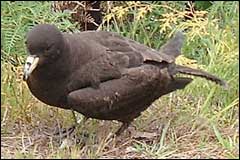Black Petrel
 Black petrels return to Great Barrier Island in October to breed |
|
 Visitors to Mt Hirakimata use walkways designed to protect black petrel burrows |
Black petrels (Procellaria parkinsoni) are tubed nosed seabirds that nest in soft-earth burrows on the slopes of forested hills. Once their range extended throughout New Zealand but they are now only found on Great and Little Barrier islands in the outer Hauraki Gulf.
These seabirds migrate east over the Pacific Ocean to feed during the winter and early spring months. They are often sighted foraging at sea towards South and Central America. They dive to catch their food as well as sitting on the sea and catching fish near the surface. The are able to dive to a depth of around 10 metres and use their wings to swim underwater. They are nocturnal feeders.
In the late spring months they return to their breeding grounds from age 4 or 5 on and mate. A single large egg is laid at the end of a burrow between 1 and 3 metres long. The egg is incubated for nearly 2 months with the parents taking turns of up to 2 weeks at a time. The chick fledges at 3 - 4 months of age.
These birds are not very good walkers and so make difficult journeys through the forest on foot to take off points. It is from these exposed points that petrels can launch themselves into the air.
Petrels rarely call during flight. Their calls are heard as they leave their nests after dark and on return in the early morning. Chicks honk or snort from about 3 weeks on, while they are in their burrows.
|
Parts of a Black Petrel |
Features |
Major Functions |
|
|
External |
Feathers |
Water proof Sooty black Heavy body |
Camouflage Warmth Buoyancy |
|
Wings |
115cm wing span Can hold stiffly with occasional wing beats
|
Flying, gliding Soaring, wheeling Diving to 10m underwater Swimming under water |
|
|
Beak or Bill |
Bluish - yellow with dark tip Short/compact Well hooked Tube nostrils |
Catching squid, fish, crustaceans Preening |
|
|
Legs and Feet |
Black Webbed |
Clumsy on ground
|
|
|
Eggs |
1 white egg in burrow above 300m |
Reproduction |